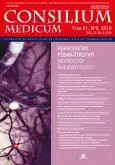НЕЙРОФИЗИОЛОГИЧЕСКИЕ ПАРАМЕТРЫ У ПАЦИЕНТОВ С МИЕЛОПАТИЯМИ НА ОТДАЛЕННОМ ЭТАПЕ РЕАБИЛИТАЦИИ
- Авторы: КОВРАЖКИНА Е.А.1
-
Учреждения:
- ФГБУ «Федеральный центр цереброваскулярной патологии и инсульта»
- Выпуск: Том 21, № 9 (2019)
- Страницы: 66-68
- Раздел: Статьи
- URL: https://journals.rcsi.science/2075-1753/article/view/95220
- DOI: https://doi.org/10.26442/20751753.2019.9.190457
- ID: 95220
Цитировать
Полный текст
Аннотация
Полный текст
Открыть статью на сайте журналаОб авторах
ЕЛЕНА АНАТОЛЬЕВНА КОВРАЖКИНА
ФГБУ «Федеральный центр цереброваскулярной патологии и инсульта»
Email: elekov2@yandex.ru
ст. науч. сотр. ФГБУ ФЦППИ Москва, Россия
Список литературы
- Борщенко И.А., Басков А.В., Коршунов А.Г., Сатанова Ф.С. Некоторые аспекты патофизиологии травматического повреждения и регенерации спинного мозга. Вопросы нейрохирургии. 2000;2: 28-31. [Borshchenko I.A., Baskov A.V., Korshunov A.G., Satanova F.S. Nekotorye aspekty patofiziologii travmaticheskogo povrezhdeniia i regeneratsii spinnogo mozga. Voprosy neirokhirurgii. 2000; 2: 28-31 (in Russian).]
- Иванова Г.Е., Крылов В.В., Цикунов М.Б. и др. Реабилитация больных с травматической болезнью спинного мозга. М., 2010. [Ivanova G.E., Krylov V.V., Tsikunov M.B. and others. Rehabilitation of patients with traumatic disease of the spinal cord. Moscow, 2010 (in Russian).]
- Крылов В.В., Гринь А.А. Травма позвоночника и спинного мозга. М., 2014. [Krylov V.V., Grin A.A. Spinal injury and spinal cord injury. Moscow, 2014 (in Russian).]
- Никитин С.С., Куренков А.Л. Магнитная стимуляция в диагностике и лечении болезней нервной системы. М., 2003. [Nikitin S.S., Kurenkov A.L. Magnetic stimulation in the diagnosis and treatment of diseases of the nervous system. Moscow, 2003 (in Russian).]
- Cheliout-Heraut F, Loubert G, Masri-Zada T et al. Evaluation of early motor and sensory evoked potentials in cervical spinal cord injury. Neurophysiol Clin 1998; 28 (1): 39-55.
- Каньшина Д.С., Кузнецов А.Н., Николаев С.Г. и др. Вариабельность представленности и латентности F-волны у пациентов в разные периоды позвоночно-спинномозговой травмы. Нервно-мышечные болезни. 2019; 9 (1): 61-6. [Kan'shina D.S., Kuznetsov A.N., Nikolaev S.G. i dr. Variabel'nost' predstavlennosti i latentnosti F-volny u patsientov v raznye periody pozvonochno-spinnomozgovoi travmy. Nervno-myshechnye bolezni. 2019; 9 (1): 61-6 (in Russian).]
- Kirshblum S, Lim S, Garstanq S, Millis S. Electrodiagnostic changes of the lower limbs in subjects with chronic complete cervical spinal cord injury. Arch Phys Med Rehabil 2001; 82 (5): 604-7.
- Nogajski JH, Enqel S, Kiernan MC. Focal and generalized peripheral nerve dysfunction in spinal cord-injured patients. J Clin Neurophysiol 2006; 23 (3): 273-9.
- Ковражкина Е.А. Нейрофизиологические параметры сегментарного и надсегментарного проведения у пациентов с различной давностью повреждений спинного мозга. Фарматека. 2017; 19 (352): 62-5. [Kovrazhkina E.A. Neirofiziologicheskie parametry segmentarnogo i nadsegmentarnogo provede-niia u patsientov s razlichnoi davnost'iu povrezhdenii spinnogo mozga. Farmateka. 2017; 19 (352): 62-5 (in Russian).]
- McKerracher L, Rosen KM. MAG, myelin and overcoming growth inhibition in the CNS. Front Mol Neurosci 2015; 8: 51.
Дополнительные файлы






